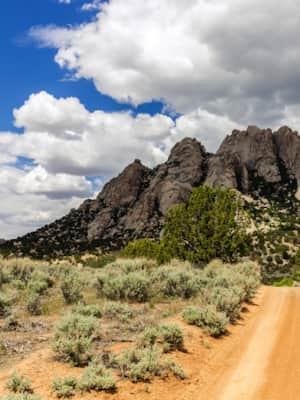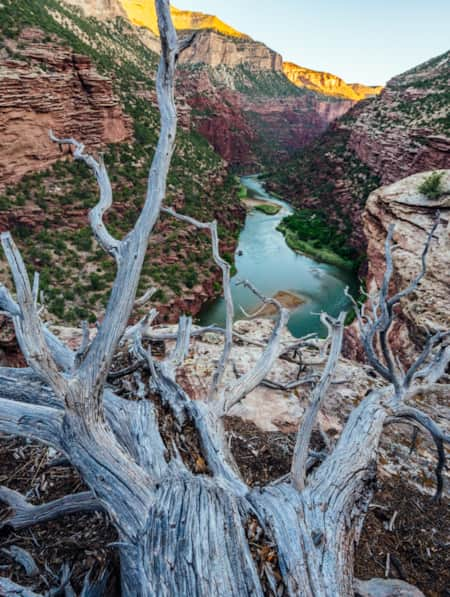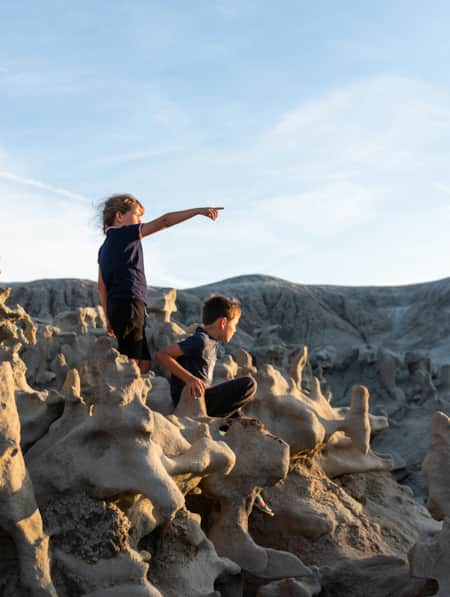Rockhounding Sites in Utah
-
Dugway Geode Beds
Rockhounding is free to the public at this geode-hunting hotspot in Utah’s West Desert. Use a shovel or pickaxe to pan through the soil in search of light, 2-4” spherical rocks. They may look dull on the outside, but split them open with a hammer to reveal the sparkling white, purple or pink crystals inside.
-
Topaz Mountain
A stone’s throw from the Dugway Geode Beds is another mineral marvel: the aptly named Topaz Mountain. Millions of years ago, volcanic activity sparked the formation of topaz, red beryl, amethyst and other semi-precious gemstones which attract amateur rockhunters to the area each year. Located about 40 miles northwest of Delta, Utah, collecting is free without a permit on most of the mountain, but watch for private property notices.
-
Trilobite Fossils & Rockhounding
To the west of Delta, Utah, lies a 40-acre shale quarry rich with prehistoric invertebrates called trilobites. U-Dig Fossils supplies the tools and know-how necessary to collect and identify trilobites and other ancient marine specimens. Paying visitors can spend a half or full-day fossil hunting, and take all of their prehistoric souvenirs home.
-
Wonderstone Quarry
Wonderstone Quarry is a peaceful, remote rockhounding site in Vernon Hills, Tooele. The area’s main attraction is the colorful, volcanic glass called wonderstone. A high-clearance vehicle is recommended to reach the quarry, which lies on both BLM land and private mining claims; do not collect anything from marked or recently mined areas.
-
Mineral Mountains
This rockhounding paradise near Beaver, Utah, is among the most mineral-rich areas in the state. Mines in these mountains (closed to the public) have yielded opal, pyrite, gold, silver, obsidian and blue beryl — one of the world’s most prized gems. The Rock Corral Recreation Area is a popular starting point for collectors, who often find spectacular pieces of smoky quartz in abundance around the picnic grounds.
Utah Rocks, Minerals & Fossils
-

Topaz
Colors: Clear, Amber, Pale Blue
Found in: Western Desert
This transparent, semi-precious mineral was designated as Utah’s official state gemstone in the 1960s. Millions of years ago, volcanic activity at the site of current-day Topaz Mountain jump-started this mineral’s over-abundance in Utah’s western counties. Topaz is a silicate mineral that forms in the veins of cooling rhyolite. It’s extremely hard, outshined only slightly by diamond. Utah topaz is a rich amber color and eventually fades to clear in the sunlight. -

Geodes
Colors: Purple, Blue, White
Found in: Western Desert
Geodes, like topaz, are a result of volcanic activity. Pockets of gas are trapped inside cooling volcanic material, creating hollow spheres which eventually fill with mineral-rich groundwater and coat the inside with crystals. Utah’s geodes are often a few inches in diameter and the brownish-gray shell contains white, purple, blue and occasionally pink crystals. To crack open a geode, place the rock inside a cloth sack to avoid flying shards and hit it swiftly with a hammer or large rock. -

Moqui Marbles
Colors: Black, Brown
Found in: Southwestern Utah
These small, dense “marbles'' are a conglomeration of sandstone and iron which range in size from blueberry to grapefruit. Moqui Marbles formed underground as iron-rich groundwater slowly coated and compacted sandstone into spheres. Whole and split, as well as conjoined and misshapen, Moqui Marbles can be found embedded in Southern Utah’s sandstone walls or covering the ground and pooling in shallow divots. Note that Moqui Marbles are most commonly found in national parks and tribal lands where rock collecting is not allowed. -

Petrified Wood
Colors: Multi, Usually Brown & Gray
Found in: Southern Utah
These remnants of Utah’s ancient forests have gone through a process called permineralization, wherein minerals seep into a fallen tree and slowly convert it to stone. The result is a colorful, kaleidoscopic specimen that has become a highly sought-after rockhounding treasure. Escalante’s Petrified Forest is one of the greatest preserves of petrified wood in the world, although collecting here is strictly prohibited. -

Trilobite Fossils
Colors: Gray, Brown
Found in: Western Desert
Trilobites are small, prehistoric marine invertebrates that roamed the shallow sea which covered Utah millions of years ago. Layers of sediment preserved these arthropods as fossils which can now be found in layers of shale throughout the state. Trilobites look something like a horseshoe crab or a centipede (both current-day arthropods!) and can be identified by their distinct head, thorax and tail segments. -

Wonderstone
Colors: Multicolored
Found in: Western Desert
Wonderstone is a variety of jasper. It’s a glassy volcanic product with gorgeous multicolored bands running throughout. No two pieces of wonderstone are exactly alike. The specific color combination depends on which minerals are present. For example, yellow and maroon bands are caused by the iron oxides. Iron is a common mineral in Utah’s biome, so wonderstone found here often features these colors.

Weaving Through Granite Mazes in the Mineral Mountains of Beaver County
The Mineral Mountains, one of Utah’s most magnificent but least known natural wonders, offer superb hikes through a rugged granite wonderland of cliffs, domes and valleys. Backcountry trails beckon with the chance to discover precious gemstones, climbing routes and airy summits with expansive views across southwestern Utah.































